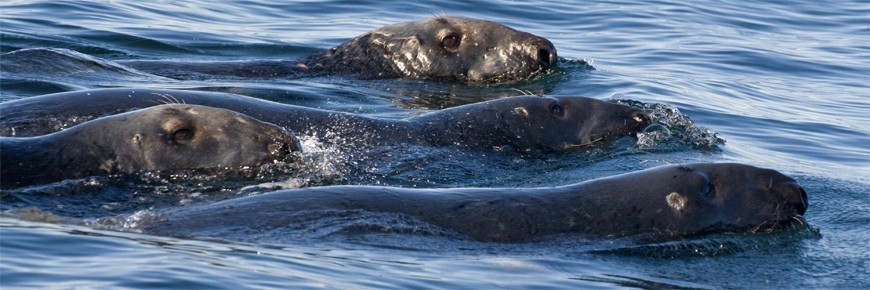
Wildlife safety
Saguenay–St. Lawrence Marine Park
- - - - - - - - - - - - - - - - - - - - - - - - - - - - - - - -
2018 UPDATE: area closed to navigation from June 21st to September 21st at Baie Sainte-Marguerite. For more details on this measure, click here.
- - - - - - - - - - - - - - - - - - - - - - - - - - - - - - - -
Navigating in the home of marine mammals
The Saguenay–St. Lawrence Marine Park's mission is to increase ecosystem protection levels for conservation purposes, for the benefit of present and future generations, while encouraging its use for educational, recreational and scientific purposes. Activities in the Marine Park are regulated with a view of ensuring the sustainable use of this area and its resources. By navigating responsibly in the Marine Park, you are helping to protect biodiversity.
An exceptional fauna
The whales, seals, and birds you see during your sea outing, for the most part, travelled thousands of kilometres to come feed here. These wild animals spend a large part of their time feeding and resting.
You are privileged to be able to watch them in their habitat and witness their natural behaviour. Pay close attention to comprehensive preservation zones. They aim at ensuring the protection of marine ecosystems, rare or sensitive habitats and species as well as important cultural resources. These areas are shown in this guide’s map: Link for the Regulations brochure.
The population of St. Lawrence belugas declining. Your participation is essential.
Residents of the marine park, beluga whales are present throughout the year in the St. Lawrence, and in the Fjord during the summer. Since 2010, issues related to birthing and the survival of calves have been observed. These whales give birth to their young in the summer particularly in July and August; so this is a critical time for the survival of calves and their mothers who need peace and quiet to raise and feed them and rest. Although the temptation is strong, do not approach them. This respectful attitude is important, whether you navigate by kayak or with any boat.
If your see one or many beluga whales:
- Don't try to approach them. KEEP YOUR DISTANCE.
- SLOW DOWN and move away, keeping at least 400 metres between you and all belugas.
- If a beluga whale comes near your vessel, SLOWLY MOVE AWAY with caution.
- In a boat: Don't stop. continue to sail until you are at least 400 metres away from the belugas, and maintain a constant speed between 5 and 10 knots. Avoid repeated changes of direction. If the 400 metre distance is impossible to maintain, stay the course.
- In a Kayak: Don't stop. Continue to paddle until you are at least 400 metres away from an beluga.
What is disturbance?
It is easy to imagine that noise can disturb the whales. After all, they use sound to navigate the waters, hunt and socialize. But noise is not the only factor that can affect whales: proximity to humans and boats too. Even a small boat as silent as a kayak or a sail boat can cause disturbance.
The St. Lawrence River and the mouth of the Saguenay Fjord are used by tens of thousands of boats each summer. Busy waterway, and favored boating destination, it is also here that the food of whales concentrates during the summer. They spend their days eating and resting in order to replenish their energy reserves, greatly needed to survive the winter and long migrations.
The presence of a boat near a whale can force the animal to change its natural behavior (rate and duration of dives, respiratory rate and communications). This is called disturbance: the animal changes its behavior due to human presence. If it is repetitive, disturbance can hinder the whale’s chances of survival and reproduction. The Marine Activities in the Saguenay–St. Lawrence Marine Park Regulations* have been developed to minimize the risk of disruption. Complying with the regulations helps to protect the whales.
*To learn more about the Regulations, visit this page: Marine Activities in the Saguenay–St. Lawrence Marine Park Regulations.
Related links
- Date modified :